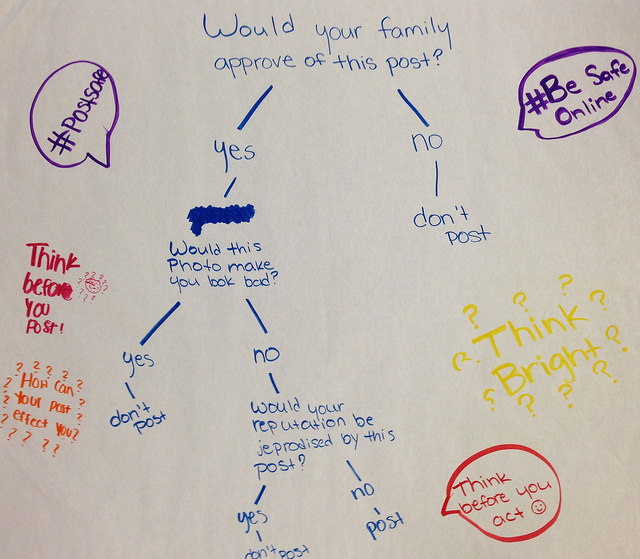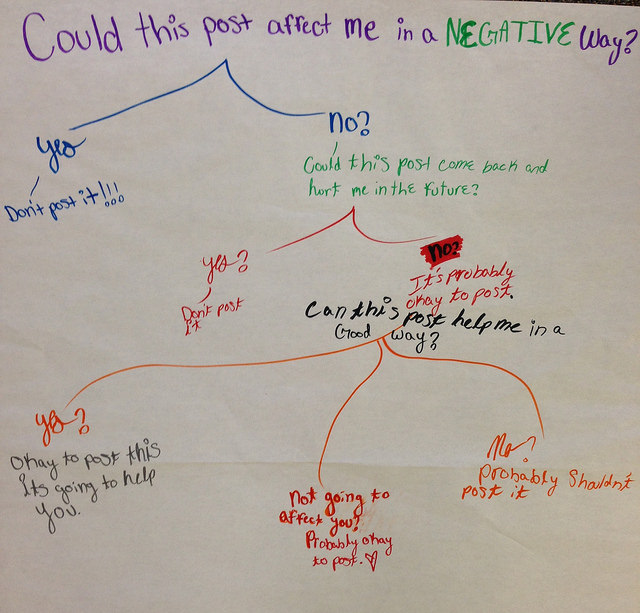Last week in the library, we did an activity that fostered a lot of great discussion and serious thoughts about posting on social media. Students honestly don’t put much thought into the things they post — and it’s scary how quick and easy it is to post something, and how difficult it is to recover from something harmful to your reputation and online presence. I work very hard to serve as a positive digital role model for my students (and coworkers, for that matter). I’m very transparent with everyone about how active I am online through social media and this blog. Sharing about the positives that come from my professional online presence and how it impacts my life is a big part of who I am and what I do. For most of my students, I may be the first POSITIVE digital role model that they have…because I see some of the things their parents are posting online on toxic Facebook groups within our community.
Some of the ideas for this activity came from the Common Sense Media lesson called Private Today, Public Tomorrow. We started with some discussion on what happens when we post things online. I used these slides to guide the activity:
Students were broken into groups and each group was given an article about the consequences of using social media in a harmful way. You could either have students access these articles online or print them. I decided to print copies, and I formatted them so they wouldn’t look wonky. Here’s the PDF:
Here are links to the articles:
Pittsburg High School students suspended for inappropriate comments on Instagram
Recruit Yuri Wright expelled for Tweets
Students arrested, expelled for making violent Twitter threats
They Loved Your G.P.A. Then They Saw Your Tweets
Social Media Shocker: Twitter and Facebook Can Cost You a Scholarship or Admissions Offer
Texas teen tweets herself out of pizzeria job
High School Coaches Back UGA’s Social Media Scrutiny
Concord coach invites Twitter to ‘burn down’ RFRA-supporting pizzeria
Students read these articles, discussed them, then came up with questions that people should ask themselves before posting on social media. Depending on the amount of time I had with the class, they might make decision trees or a list of questions. Here are some of their products:
We ended with a whole class discussion. It was really interesting to see where the discussion went with each of the different classes. We talked about what they read in the articles (some were shocked that these were TRUE stories) and they shared their group’s questions (or decision tree). Lots of discussion was had about how “appropriate” is a subjective word. This is one of those lessons that will be referenced regularly, especially since a number of administrators popped in during these discussions.
I did this activity with all of my 7th and 8th grade students — 24 times total in four days! I plan to do it earlier in the year next year with the incoming 7th grade students. This activity would be very relevant to high school students, as well!


I really like this. Do you have regular schedule classes coming in and do you sometimes take advantage of that to do these presentations? I’d love to do similar things like this, being in a junior high setting, and teach students, especially grade 9, on digital literacy and the importance of things we post and how they could backfire if the “wrong” person sees the information.
– Krys
Yes, I have my ELA classes on a fixed schedule so I’m sure to see them regularly (6th & 7th grades every other week; 8th grade every third week). The rest of my schedule is open for scheduling. I often do lessons like this, or a collaborative lesson that the ELA teachers and I have planned together.
Did you have any parents concerned over content in the articles? I would like to teach a similar lesson to 6th graders, but wondering if I should seek out some articles that might not be as “controversial” Thoughts?
That’s why I didn’t do this lesson with the 6th graders, I thought the content of some of the articles was a little more mature. Some of the articles would be okay (or could easily be edited to take out some of the more controversial material) and I’m sure other articles could be found that would be more appropriate for 6th graders.
How long was this lesson? I will have 50 minute classes this year with my middle schoolers and see them every other day. You did a really nice job with this and I would like to use this as a lesson as part of a unit on digital citizenship with my 7th and 8th grade library students.
This lesson probably took about 40 minutes — I was observed during this lesson and it got a great review. The students were very engaged and the discussion was great!
I really enjoyed reading this posting. I think it is very important to teach students about social media and what is right or wrong to post online. I wonder if this lesson could be adjusted or tailored to a younger groups of students (k-2). I think this would be a good backup lesson to what my Technology Facilitator is going over in computer with them.
I love this! I recently started a 5-8 grade position and I teach Information literacy to all the grades. A big part of the course is Digital Citizenship. I am excited to use this with them.
I love this lesson! Planning to implement it very soon with my high school ELA classes…thanks Tiffany!